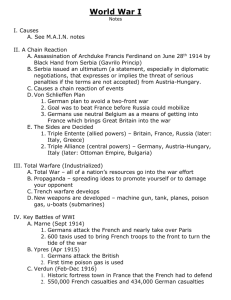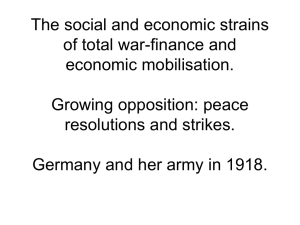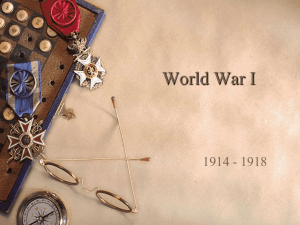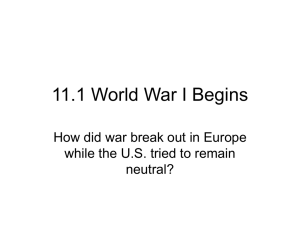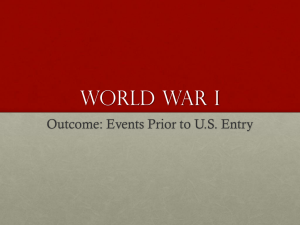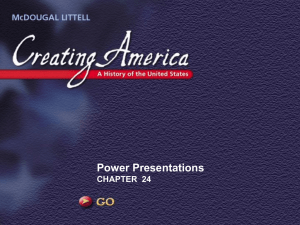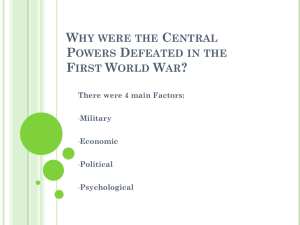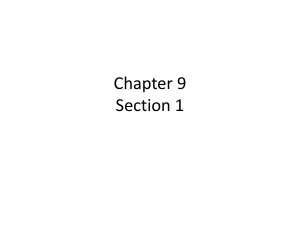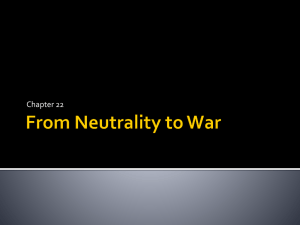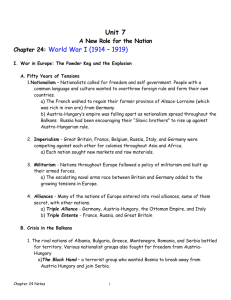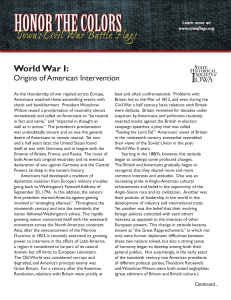KT`s (ch.23) p.614-646
advertisement
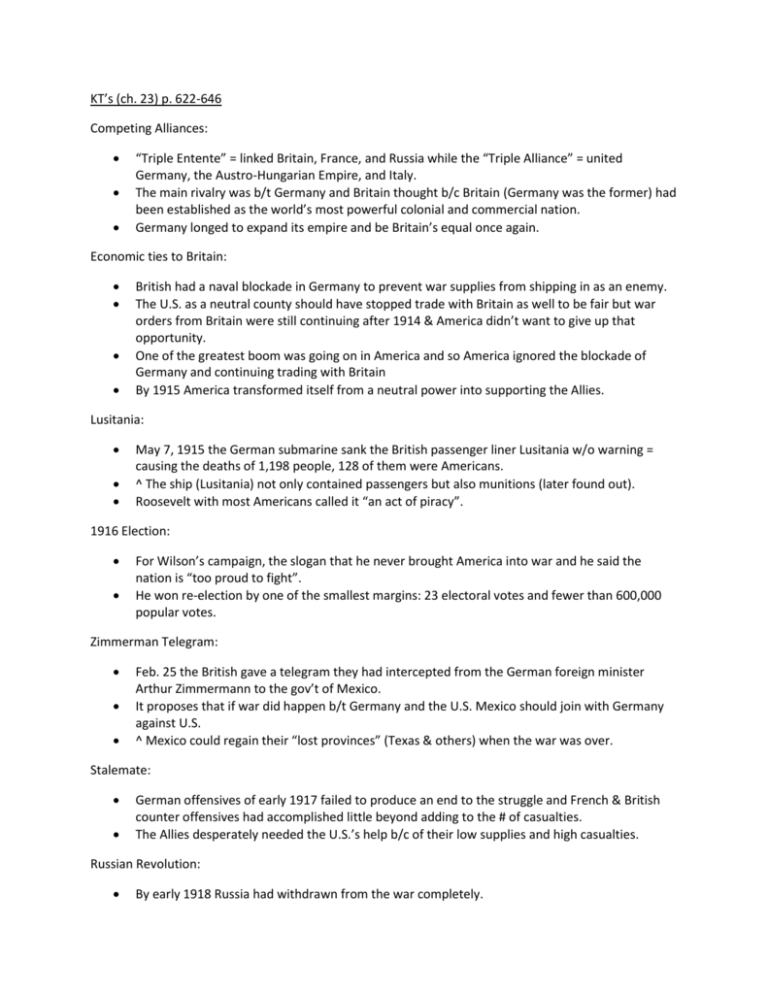
KT’s (ch. 23) p. 622-646 Competing Alliances: “Triple Entente” = linked Britain, France, and Russia while the “Triple Alliance” = united Germany, the Austro-Hungarian Empire, and Italy. The main rivalry was b/t Germany and Britain thought b/c Britain (Germany was the former) had been established as the world’s most powerful colonial and commercial nation. Germany longed to expand its empire and be Britain’s equal once again. Economic ties to Britain: British had a naval blockade in Germany to prevent war supplies from shipping in as an enemy. The U.S. as a neutral county should have stopped trade with Britain as well to be fair but war orders from Britain were still continuing after 1914 & America didn’t want to give up that opportunity. One of the greatest boom was going on in America and so America ignored the blockade of Germany and continuing trading with Britain By 1915 America transformed itself from a neutral power into supporting the Allies. Lusitania: May 7, 1915 the German submarine sank the British passenger liner Lusitania w/o warning = causing the deaths of 1,198 people, 128 of them were Americans. ^ The ship (Lusitania) not only contained passengers but also munitions (later found out). Roosevelt with most Americans called it “an act of piracy”. 1916 Election: For Wilson’s campaign, the slogan that he never brought America into war and he said the nation is “too proud to fight”. He won re-election by one of the smallest margins: 23 electoral votes and fewer than 600,000 popular votes. Zimmerman Telegram: Feb. 25 the British gave a telegram they had intercepted from the German foreign minister Arthur Zimmermann to the gov’t of Mexico. It proposes that if war did happen b/t Germany and the U.S. Mexico should join with Germany against U.S. ^ Mexico could regain their “lost provinces” (Texas & others) when the war was over. Stalemate: German offensives of early 1917 failed to produce an end to the struggle and French & British counter offensives had accomplished little beyond adding to the # of casualties. The Allies desperately needed the U.S.’s help b/c of their low supplies and high casualties. Russian Revolution: By early 1918 Russia had withdrawn from the war completely. ^ After the Bolshevik Revolution in Nov. 1917 a new gov’t led by V.I. Lenin negotiated hasty & costly peace with the Central Powers = freeing additional German troops to fight on the western front. Selective Service Act: House speaker Champ Clark said that “there is precious little difference b/t a conscript and a convict”. He won passage of the Selective Service Act in mid-May. Draft brought 3 million men into the army and another 2 million joined various branched of the armed services voluntarily. ^ Together they formed what became known as the American Expeditionary Force (AEF). African – American Soldiers: Almost 400,000 black soldiers enlisted in or were drafted into the army and navy as well. (Marines wouldn’t accept them). Most of them performed small tasks on military bases in the U.S. more than 50,000 went to France. A.A. fought in segregated, all black units under white commanders and even in Europe most of them were assigned to noncombat duty. ^ But some black units fought bravely in 1918. Most A.A. lived with the racism they encountered hoping that their military service would improve their status. General John Pershing: Eight months after the spring of 1918 the war was over under the command of General John J. Pershing who had recently been leading the unsuccessful American pursuit of Pancho Villa, the American Expeditionary Force. It command structure independent of the other Allies – joined the existing Allied forces. Chateau-Thierry: June 1918, American forces at Chateau-Thierry assisted the French in repelling a German offensive that brought German forces within 50 miles of Paris. By July 18, the Allies and halted the German advance and were beginning a successful offensive of their own. Meuse-Argonne Offensive: Sept. 26, American fighting force advanced against the Germans in the Argonne Forest in the southern part of a 200 mile attack = lasted 7 weeks. End of Oct. Americans pushed the Germans back toward their own border and cut their major supply lines to the front. High Casualty Rates: A million men died from the British Empire (Britain, Canada, Australia, India, and others). France lost 1.7 million men, Germany – 2 million and former Austro-Hungarian Empire – 1.5 million, Italy – 460,000, and Russia 1.7 million. Financing the war: When the war ended, the U.S. gov’t had spent $32 billion relating to the conflict. ^ a very large sum at the time. The entire federal budget had rarely gone past $1 billion before 1915 and as of 1910; the nation’s entire gross national product had only been $35 billion. The gov’t started selling “Liberty Bonds” to the public and earned $23 billion from that as well as the additional taxes = $10 billion. War Industries Board: An agency created in July 1917 to coordinate gov’t purchases of military supplies. It was organized at first worst then in 1918 Wilson restructured it and placed it under the control of Wall St. financier = Bernard Baruch. Lessons of the Managed Economy: b/c of the war, efforts to organize the economy = accomplishments. Hoover’s efficient organization of domestic food supplies. William McAdoo’s success in untangling the RRs. Some areas = progress too slow that many supplies STILL weren’t ready when the war was over. Ludlow Massacre: 1914, Ludlow, Colorado workers (Italians, Greeks & Slavs) walked out of the coal mines owned by John D. Rockefeller. They continued with the strike (w/ their daughters & wives) even after they got kicked out form the co. housing & moved into erected tents. State Militia was called in to help miners but often helped employers defeat the strike instead. Strike breakers & militia attacked the worker’s tent colony (39 people died & 11 of them were children). “Great Migration”: During the war = most important social change = hundreds of thousands of A.A. from rural South into northern industrial cities. Result = “push” & “pull”, pull was the prospect of factory jobs in the urban north & opportunities where blacks could enjoy more freedom. Push = poverty, debt, racism, & violence in the South. Race Riots: East St. Louis, Illinois a white mob attacked a black neighborhood on July 2, 1917 = burned down many houses & shot residents as they escaped = 40 A.A. died. Women’s Peace Party: Most active & widespread peace activism came from women’s movement. 1915, Carrie Chapman Catt (leader of women suffrage) helped create Women’s Peace Party (small but active membership). As war continues in Europe, Party’s effort to keep U.S. out of it grew. Maternal Opposition to War: Women peace activists shared many of the political and economic objections to the war of the Socialist Party. ^ but some criticized the war also b/c of their morals & maternal basis for their pacifism. CPI: CPI =Committee on Public information (gov’t effort) to rally public support and had a vast campaign by the CPI. The committee was under the leadership of Denver journalist George Creel (who spoke openly about the importance of social unity). CPI supervised the distribution of pro-war literature (75 million pieces of printed materials in all). War posters were plastered on the walls of offices, ships, theaters, schools, churches, and homes. Creel encouraged reporters to exercise “self-censorship” when reporting news about the struggle. At first the CPI held a mild tone about the war but later on their tactics became increasingly crude. ^ It encouraged Americans to believe that Germans were really savages. Espionage Act: The Espionage Act was established in 1917 gave the gov’t the right to create stiff penalties for spying, sabotage, or obstruction of the war effort. ^ It also empowered the post office to ban “seditious” materials from the mails. (Sedition = statements that encourage insubordination & anything that suggested that the gov’t was controlled by Wall Street/ Monopolies). Sedition Act: Sabotage Act of April 20, 1918 & the Sedition Act of May 16, 1918. These bills expanded the meaning of the Espionage Act = to make any public expression of opposition to the war illegal. ^ It allowed officials to prosecute anyone who criticized the president or the gov’t. Repressing Dissent: State & local gov’ts, corp., universities, and private citizens added to putting down the resistance to war. Mobs sprang up to “discipline’ those who dared challenge the war or the government. “100% Americanism”: There were organizations who enlisted services of “agents” to pry into activities of their neighbors and trying to find evidence of anti-war. Immigrants were frequent victims ^ b/c of the countries they came from: Irish had a past of conflicting with Britain, Jews b/c they expressed opposition to the anti-Semitic policies o the Russian gov’t. “Loyalist” citizens’ groups policed immigrant neighborhoods and monitored meetings and sometimes conversations for signs of disloyalty. The greatest target = German-Americans, while many opposed U.S. intervention on behalf of the Allies most German Americans supported the war effort when it began. Many German products were banned: performances of German music were frequently banned, German books were removed from the shelves of libraries, and courses in German language were removed from school curricula. Germans were routinely fired from jobs in war industries b/c they might “sabotage” important tasks. ^ Many were fired from positions that were entirely unrelated to the war. Wilson’s Idealistic Vision: Jan. 8, 1918 Wilson proposed to Congress the principles he thought the nation was going to war for. ^ had 14 distinct provisions and they fell into 3 broad categories. (1st)Wilson’s proposals contained 8 specific recommendations for adjusting postwar boundaries & for establishing new nations to replace the defunct Austro-Hungarian & Ottoman Empires. (2nd) there were 5 general principles to govern international conduct in the future: freedom of seas, open covenant instead of secret treaties, reductions in armaments, free trade, and impartial mediation of colonial claims. Finally there was a proposal for a league of nations that would help implement these new principles & territorial adjustments and resolve future controversies. Lenin’s Challenge: The 14 points could also be an answer to the new Bolshevik gov’t in Russia = Dec. 1917 Lenin issued his own statement of war aims similar to Wilsons. Allied Intransigence: Britain and France have been storing up great bitterness against Germany after the many years of war. ^ They weren’t in the mood for Wilson’s benign and peaceful view for the end of the war. The British Prime Minister David Lloyd George insisted for a time that the German Kaiser be captured and executed. He & Georges Clemenceau, president of France remained determined to the end to gain something from the struggle to compensate them for the catastrophe they had suffered. The Big Four: The principal figures showed up for the negotiations = leaders of the victorious Allied nations. Lloyd George (Great Britain), Clemenceau (France), Vittorio Orlando (Italy), and Wilson (America). Wilson’s Retreat: Wilson was unable to win approval of many of the broad principles he had brought up. Many of his points weren’t supported, even the most basic ones that Congress suggested he announce. Reparations: Wilson opposed demanding compensation from the defeated Central Powers. ^ the other Allied leaders were determined though and soon Wilson gave in, the figure was established in 1921 = $56 billion supposedly to pay for damages to civilians & for military pensions. ^ In the end Germany only had to pay $9 billion, which was till more than its crippled economy could afford. ^ the reparations was combined with other territorial & economic penalties = effort to keep Germany not only weak not only now but in the future as well. League of Nations: Wilson’s most important triumph was the one most important to him = creation of a permanent international org. to oversee world affairs and prevent future wars. Jan. 25, 1919 the Allies voted to accept the “covenant” of the League of Nations. Henry Cabot Lodge: Senator from M.A. and a powerful chairman of the Foreign Relations Committee. ^ He hated the president with genuine passion and used every possible tactic to obstruct, delay, and amend the treaty. New Social Environment: The social environment after 1918 was no longer open to progressive reform and the American economy was suffering from a severe post-war recession. Much of middle-class Americans responded to demands for change with a fearful, conservative hostility. The aftermath of the war brought a period of repression and reaction. Postwar Recession: Inflation began killing the market for consumer goods b/c the wartime boom ended so quickly and unexpected. 1920-1921 gross national product declined 10% and 100,000 businesses went bankrupt, 453,000 farmers lost their land, and 5 million Americans lost their jobs. Boston Police Strike: Sept. there was a strike by the Boston police force which was responding to layoffs and wage cuts by demanding recognition of its union. ^ with the Boston police off on their jobs = Boston erupted in violence & looting. New Black Attitudes: After the war, it increased black bitterness and increased black determination to fight for their rights. The soldiers expected some social reward for their service and for many other America blacks the war had raised economic expectations as they moved into industrial and other jobs vacated by white workers. Chicago Race Riots: Blacks gathered in crowds and marched into white neighborhoods to retaliate for the black teen’s stoning. The whites formed even larger crowds and roamed into black neighborhoods shooting, stabbing, and beating passersby, destroying homes & prop. It lasted for more than a week, 38 people died, 15 whites & 23 blacks. 537 were injured and over 1,000 people were left homeless. Happened during 1919 in the summer. Marcus Garvey’s Black Nationalism: A black Jamaican who attracted a large crowd of American poor urban blacks with the ideology of Black Nationalism. Garvey encouraged A.A. to take pride in their own achievements & to develop an awareness of their African heritage. His United Negro Improvement Association (UNIA) launched a chain of black-owned grocery stores and pressed for the creation of other black businesses. Eventually Garvey began to urge is supporters to leave America and return to Africa where they could create a new society of their own. His association began to decline after Garvey was indicted in 1923 on charges of business fraud and deported to Jamaica two years later. Popular Antiradicalism: The middle-class of America was determined to fight back against the radicals. It became known as the Red Scare. Antiradical newspapers & politicians now began to portray almost every form of instability or protest as a sign of a radical threat. Citizens removed books from the shelves of libraries, administrators in some universities dismissed “radical” members from their faculties. Greatest contribution to the Red Scare = came from federal gov’t = on new years’ day 1920, Attorney General A. Mitchell Palmer & his ambitious assistant J. Edgar Hoover arrested 6,000 people at radical centers throughout the country. Sacco & Vanzetti: May of 1920, 2 Italian immigrants Nicola Sacco & Bartolomeo Vanzetti were charge w/ the murder of a paymaster in Braintree, MA. Little evidence but both men confessed that they were anarchists and faced with widespread presumption of guilt. & sentenced to death and over the next several yrs. support for Sacco & Vanzetti grew to formidable proportions. August 23, 1927 with widespread protests around the world, Sacco & Vanzetti still proclaiming their innocence died in the electric chair. Return to “Normalcy”: Republic presidential nominee of 1920, Warren Gamaliel Harding, an obscure Ohio senator had a different vision from Wilson. He offered no ideals, only a vague promise of a return as he later phrased it to “normalcy”. & = won in a landslide, the Republicans won with 61% of popular vote and carried every state outside the South. = Party made major gains in Congress as well.

